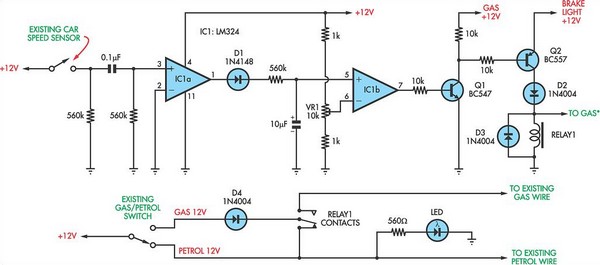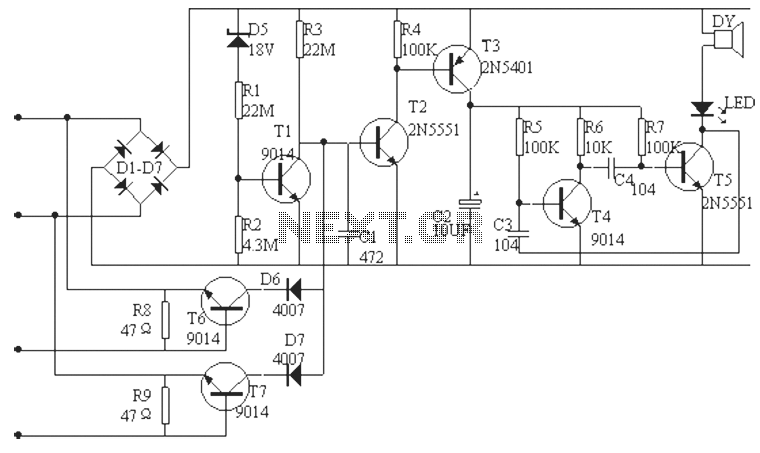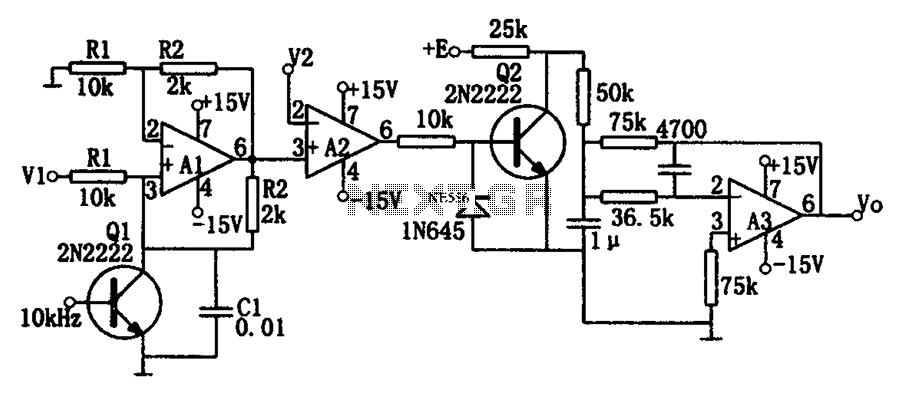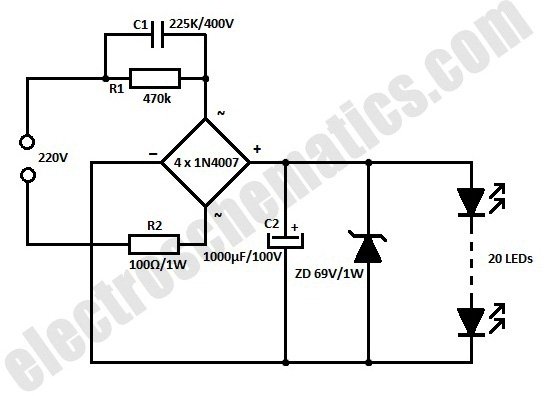
Touch Light Dimmer circuit
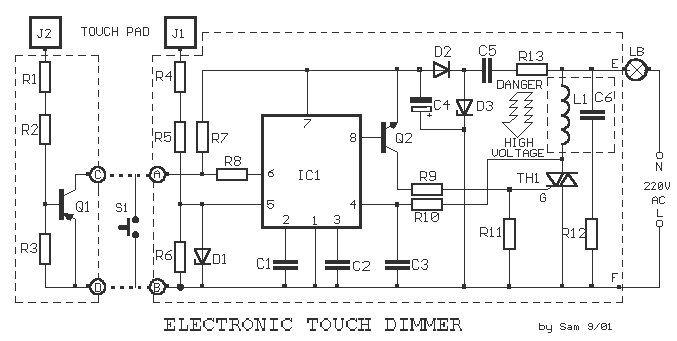
With this circuit we can change the brightness of lamb, with a only key of touch. The key of touch is connected in the circuit, center of which is a special completed IC1, which is the S566B of SIEMENS. This IC, it processes the information of duration of touch and then it checks the brilliance of lamb, according to this information. If we touch upon the key for a small period of time (60 until 400 ms), the lamb simply only changes situation, that is to say from OFF in ON or on the contrary, depended from the situation is found itself before the unit. In one of bigger duration of touch (more from 400ms), is altered the brilliance of lamb, late from dark in luminous or on the contrary. Are required roughly seven seconds, in order to we have complete brilliance. More: When it stops touch of key, remains that prevailing level of brilliance, in moment. With short contact (OFF), the selected brightness is stored. This level of brightness, comes back with a new short touch, in the switch (ON). In the case of fluctuation of brightness, the control begins from the point that has been stored. The unit can be checked from distance with a external circuit of touch or from a pressing switch S1, also can are placed also other switches at the parallel, in different points, long from the unit. The circuit is designed to work with the modern designing of wirings in a house, where lambs are connected in the neutral line and the switches (or the dimmer), are connected in the line of phase. If the circuit is connected in the neutral line and lamb in the phase, then the handling becomes exclusively from pressing switches. The circuit can check power, above 300W. The manufacture requires attention, one and the presence of high voltage of network is present. Also his insulation, need it is very good. The L1-C6 and R12, are elements of repression of interjections. The coil L1 is wrapped, tour from capacitor C6 and they are roughly 50 coils of cupreous wire, cross-section 0.5mm, which well are insulation, with a insulation material. When it finishes the circuit it can become control for interjections, with a radio. If it exists interjection then can become effort is decreased the price of R12, in 47R. ATTENTION!!! In voltage when you work with the circuit. Also if you use extensions for the control, for likely existence of high voltage. Attention also in the IC1, is type S566B SIEMENS and it does not have no relation with the NE566N, that is oscillator checked from voltage.
The circuit utilizes a touch-sensitive switch to control the brightness of a lamp. The core component, the S566B IC from Siemens, is responsible for interpreting the duration of the touch input and adjusting the lamp's brightness accordingly. A short touch (between 60 ms and 400 ms) toggles the lamp state between OFF and ON, while a longer touch (over 400 ms) gradually adjusts the brightness. This gradual adjustment can take up to seven seconds to reach full brightness, providing a smooth transition for the user.
When the touch is released, the circuit retains the last brightness level, which can be reactivated with another short touch. This feature allows for easy recall of preferred brightness settings. The circuit is designed to operate within modern household wiring systems, where lamps are typically connected to the neutral line and switches to the phase line. This distinction is crucial for proper operation; connecting the circuit incorrectly can limit functionality to manual switches only.
The circuit is capable of controlling loads above 300W, making it suitable for a variety of lighting applications. However, caution is advised due to the presence of high voltage in the circuit. Proper insulation and handling practices must be observed to ensure safety. The inductive component (L1) and capacitive elements (C6) work together to filter out electrical noise, enhancing the reliability of the touch input. L1 is constructed from approximately 50 turns of 0.5 mm copper wire, ensuring adequate insulation to prevent short circuits.
In cases where electrical interference is detected, adjustments can be made to the resistance of R12 to improve performance. It is important to note that the S566B IC should not be confused with the NE566N, as they serve different functions within electronic circuits. The circuit's design incorporates various resistors and capacitors to stabilize operation and enhance signal processing, ensuring a user-friendly experience in controlling lighting brightness effectively.With this circuit we can change the brightness of lamb, with a only key of touch. The key of touch is connected in the circuit, center of which is a special completed IC1, which is the S566B of SIEMENS. This IC, it processes the information of duration of touch and then it checks the brilliance of lamb, according to this information.
If we touch upon the key for a small period of time (60 until 400 ms), the lamb simply only changes situation, that is to say from OFF in ON or on the contrary, depended from the situation is found itself before the unit. In one of bigger duration of touch (more from 400ms), is altered the brilliance of lamb, late from dark in luminous or on the contrary.
Are required roughly seven seconds, in order to we have complete brilliance. When it stops touch of key, remains that prevailing level of brilliance, in moment. With short contact (OFF), the selected brightness is stored.This level of brightness, comes back with a new short touch, in the switch (ON). . In the case of fluctuation of brightness, the control begins from the point that has been stored. The unit can be checked from distance with a external circuit of touch or from a pressing switch S1, also can are placed also other switches at the parallel, in different points, long from the unit.
The circuit is designed to work with the modern designing of wirings in a house, where lambs are connected in the neutral line and the switches (or the dimmer), are connected in the line of phase. If the circuit is connected in the neutral line and lamb in the phase, then the handling becomes exclusively from pressing switches.
The circuit can check power, above 300W. The manufacture requires attention, one and the presence of high voltage of network is present. Also his insulation, need it is very good.. The L1-C6 and R12, are elements of repression of interjections. The coil L1 is wrapped, tour from capacitor C6 and they are roughly 50 coils of cupreous wire, cross-section 0.5mm, which well are insulation, with a insulation material. When it finishes the circuit it can become control for interjections, with a radio. If it exists interjection then can become effort is decreased the price of R12, in 47R. ATTENTION!!! In voltage when you work with the circuit. Also if you use extensions for the control, for likely existence of high voltage. Attention also in the IC1, is type S566B SIEMENS and it does not have no relation with the NE566N, that is oscillator checked from voltage.
R1-2-3= 4M7 D1= 18V 1W IC1= S566B SIEMENS R4-5-6= 4M7 D2= 1N40001 Q1= BC212L R7-8= 470K D3= 15V 1W Q2= BC182L R9= 120R C1-2= 47nF 250V TH1= TIC206D R10= 1M5 C3= 470pF ceramic S1= Push Button switch R11= 10K C4= 100uF 25V LB= Lamb 220V >300W R12= 100R (47R) C5= 220nF 630V L1= 50 turns 0.5mm up C6 R13= 1K 1W C6= 100nF 630V J1-2= Touch Pad 🔗 External reference
The circuit utilizes a touch-sensitive switch to control the brightness of a lamp. The core component, the S566B IC from Siemens, is responsible for interpreting the duration of the touch input and adjusting the lamp's brightness accordingly. A short touch (between 60 ms and 400 ms) toggles the lamp state between OFF and ON, while a longer touch (over 400 ms) gradually adjusts the brightness. This gradual adjustment can take up to seven seconds to reach full brightness, providing a smooth transition for the user.
When the touch is released, the circuit retains the last brightness level, which can be reactivated with another short touch. This feature allows for easy recall of preferred brightness settings. The circuit is designed to operate within modern household wiring systems, where lamps are typically connected to the neutral line and switches to the phase line. This distinction is crucial for proper operation; connecting the circuit incorrectly can limit functionality to manual switches only.
The circuit is capable of controlling loads above 300W, making it suitable for a variety of lighting applications. However, caution is advised due to the presence of high voltage in the circuit. Proper insulation and handling practices must be observed to ensure safety. The inductive component (L1) and capacitive elements (C6) work together to filter out electrical noise, enhancing the reliability of the touch input. L1 is constructed from approximately 50 turns of 0.5 mm copper wire, ensuring adequate insulation to prevent short circuits.
In cases where electrical interference is detected, adjustments can be made to the resistance of R12 to improve performance. It is important to note that the S566B IC should not be confused with the NE566N, as they serve different functions within electronic circuits. The circuit's design incorporates various resistors and capacitors to stabilize operation and enhance signal processing, ensuring a user-friendly experience in controlling lighting brightness effectively.With this circuit we can change the brightness of lamb, with a only key of touch. The key of touch is connected in the circuit, center of which is a special completed IC1, which is the S566B of SIEMENS. This IC, it processes the information of duration of touch and then it checks the brilliance of lamb, according to this information.
If we touch upon the key for a small period of time (60 until 400 ms), the lamb simply only changes situation, that is to say from OFF in ON or on the contrary, depended from the situation is found itself before the unit. In one of bigger duration of touch (more from 400ms), is altered the brilliance of lamb, late from dark in luminous or on the contrary.
Are required roughly seven seconds, in order to we have complete brilliance. When it stops touch of key, remains that prevailing level of brilliance, in moment. With short contact (OFF), the selected brightness is stored.This level of brightness, comes back with a new short touch, in the switch (ON). . In the case of fluctuation of brightness, the control begins from the point that has been stored. The unit can be checked from distance with a external circuit of touch or from a pressing switch S1, also can are placed also other switches at the parallel, in different points, long from the unit.
The circuit is designed to work with the modern designing of wirings in a house, where lambs are connected in the neutral line and the switches (or the dimmer), are connected in the line of phase. If the circuit is connected in the neutral line and lamb in the phase, then the handling becomes exclusively from pressing switches.
The circuit can check power, above 300W. The manufacture requires attention, one and the presence of high voltage of network is present. Also his insulation, need it is very good.. The L1-C6 and R12, are elements of repression of interjections. The coil L1 is wrapped, tour from capacitor C6 and they are roughly 50 coils of cupreous wire, cross-section 0.5mm, which well are insulation, with a insulation material. When it finishes the circuit it can become control for interjections, with a radio. If it exists interjection then can become effort is decreased the price of R12, in 47R. ATTENTION!!! In voltage when you work with the circuit. Also if you use extensions for the control, for likely existence of high voltage. Attention also in the IC1, is type S566B SIEMENS and it does not have no relation with the NE566N, that is oscillator checked from voltage.
R1-2-3= 4M7 D1= 18V 1W IC1= S566B SIEMENS R4-5-6= 4M7 D2= 1N40001 Q1= BC212L R7-8= 470K D3= 15V 1W Q2= BC182L R9= 120R C1-2= 47nF 250V TH1= TIC206D R10= 1M5 C3= 470pF ceramic S1= Push Button switch R11= 10K C4= 100uF 25V LB= Lamb 220V >300W R12= 100R (47R) C5= 220nF 630V L1= 50 turns 0.5mm up C6 R13= 1K 1W C6= 100nF 630V J1-2= Touch Pad 🔗 External reference
